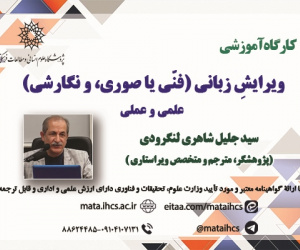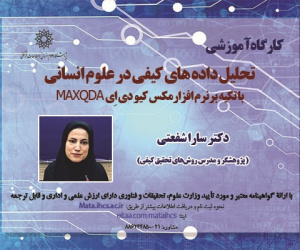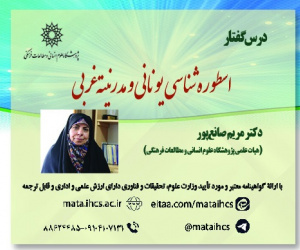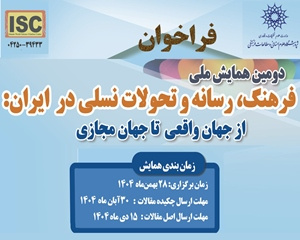خوانش وجوه بصری بدن گروتسک در پوسترهای تئاتر و سینمای دهه 1390 ایران (مقاله علمی وزارت علوم)
درجه علمی: نشریه علمی (وزارت علوم)
آرشیو
چکیده
گروتسک با تأثیرگذاری بر ساختارهای مفهومی و گفتمانی، نقشی کلیدی در تولید معنا ایفا می کند و حضور آن را می توان در پوسترهای فرهنگی معاصر ایران مشاهده کرد. پژوهش حاضر با این پرسش آغاز گردیده است که بر اساس آرای میخائیل باختین، وجوه بصری بدن گروتسک در پوسترهای تئاتر و سینمای دهه 1390 ایران چگونه نمود یافته است؟ و بازتاب بدن گروتسک در پوسترهای تئاتر و سینمای دهه 1390 ایران، دارای چه مفاهیمی است؟ هدف نیز تحلیل ویژگی های بصری پوسترهای تئاتر و سینمای دهه 1390 ایران و عملکرد ویژگی های گروتسک به منظور انتقال معنا و مفاهیمی نو و برقراری ارتباطی عمیق با مخاطب است. روش تحقیق توصیفی تحلیل محتوا و شیوه گردآوری اطلاعات کتابخانه ای و از طریق فیش برداری و تصویرخوانی است. روش تجزیه و تحلیل داده ها کیفی و روش نمونه گیری هدف مند است. نتایج پژوهش نشان می دهد، مفهوم گروتسک در پوسترهای فرهنگی معاصر ایران به معنای نمایش پیکره در رابطه با طبیعت و زندگی وارونه است. همچنین به آشفتگی ها، دگرگونی ها و ترس های انسان می پردازد. تجربه زیست فردی در جهان هستی، همراه با الگوی زیبایی شناسی متاثر از نگاه باختین، مرزی مبهم در آثار ایجاد کرده که به ظهور ویژگی های خاص گروتسک در پوسترهای تئاتر و سینمای ایران در دهه ۱۳۹۰ منجر شده است.Reading the Visual Aspects of the Grotesque Body in the Iranian Cinema and Theater Posters (1390s)
Grotesque is an artistic and literary form that has appeared in contemporary art, having a history as long as the 16th century. According to Mikhail Bakhtin, a 20th-century literary theorist, a critical approach is formed in the official space of society, which is connected with the values and ways of human social behavior in the contemporary world, and literary, visual, and cultural studies can provide the basis for planning and understanding the dimensions of artistic life. Bakhtin’s perspective regarding the Carnival of the Middle Ages led to the creation of a humorous culture within an informal domain. In the history of literature and art, as well as in cultural and social situations, classical laws, standards, and proportions have always contrasted with the grotesque, and any pre-determined conceptual frameworks are abandoned. This critical attitude develops in the formal space of the community, which is related to free emancipation and the formation of a new personality. Also, the grotesque attitude motivates community members to engage in social debate and discuss issues of form and identity change. Grotesque represents conflict, fear, exaggeration, laughter, change, or confusion in the creation of artistic or literary work. The new approach toward social life can be portrayed as a way that everything overpowering, dry, and serious is overturned and mocked to adapt to the surroundings and people. The concept of a grotesque body proposed by Mikhail Bakhtin serves as the theoretical foundation for this study. In a grotesque body, inconsistency, and ambiguity are caused by the reflection of abnormal things in the body and face, resulting in the abandonment of established standards in the representation of the body and face and deform them into something weird yet familiar. The current research began by asking how the visual characteristics of the grotesque body appeared in Iranian theater and movie posters in the 1390s. What are the concepts expressed by the reflection of the grotesque body in 1390s Iranian theatrical and movie posters? The current research aims to analyze the visual features of Iranian theater and movie posters of the 1390s and grotesque features, to convey a novel definition and concept to provide a deep communication with the audience. The descriptive research method includes content analysis and library information collecting methods, through note-taking and image reading. The data analysis method has been qualitative and sampling has been goal-oriented. The results of this research suggest that the idea of grotesque in modern Iranian cultural posters refers to the illustration of a human being in connection with nature and an inverted life, expressing an ambiguous element. Also, it covers human disturbances, transformations, and phobias, which have found a critical and societal function. Individual life experiences in the world, combined with an aesthetic model influenced by Bakhtin's viewpoint, have resulted in the construction of an indeterminate border in the works, which creates the distinguishing element of the grotesque in Iranian theater and film posters in the 1390s.







